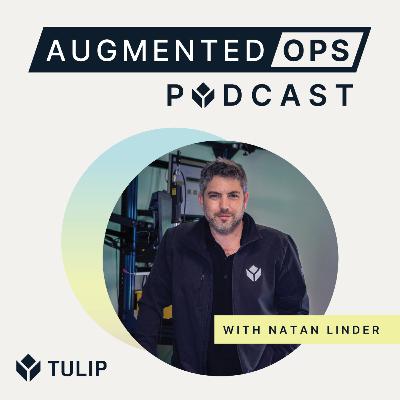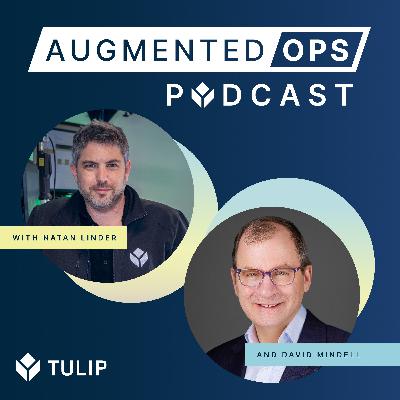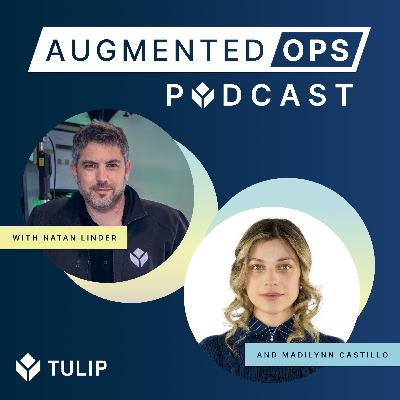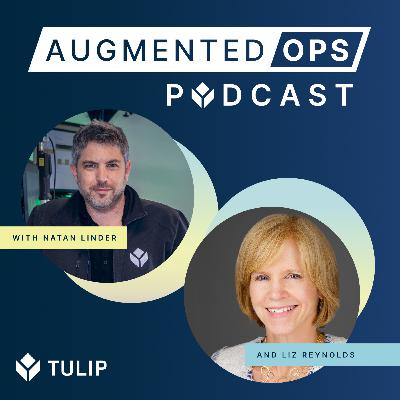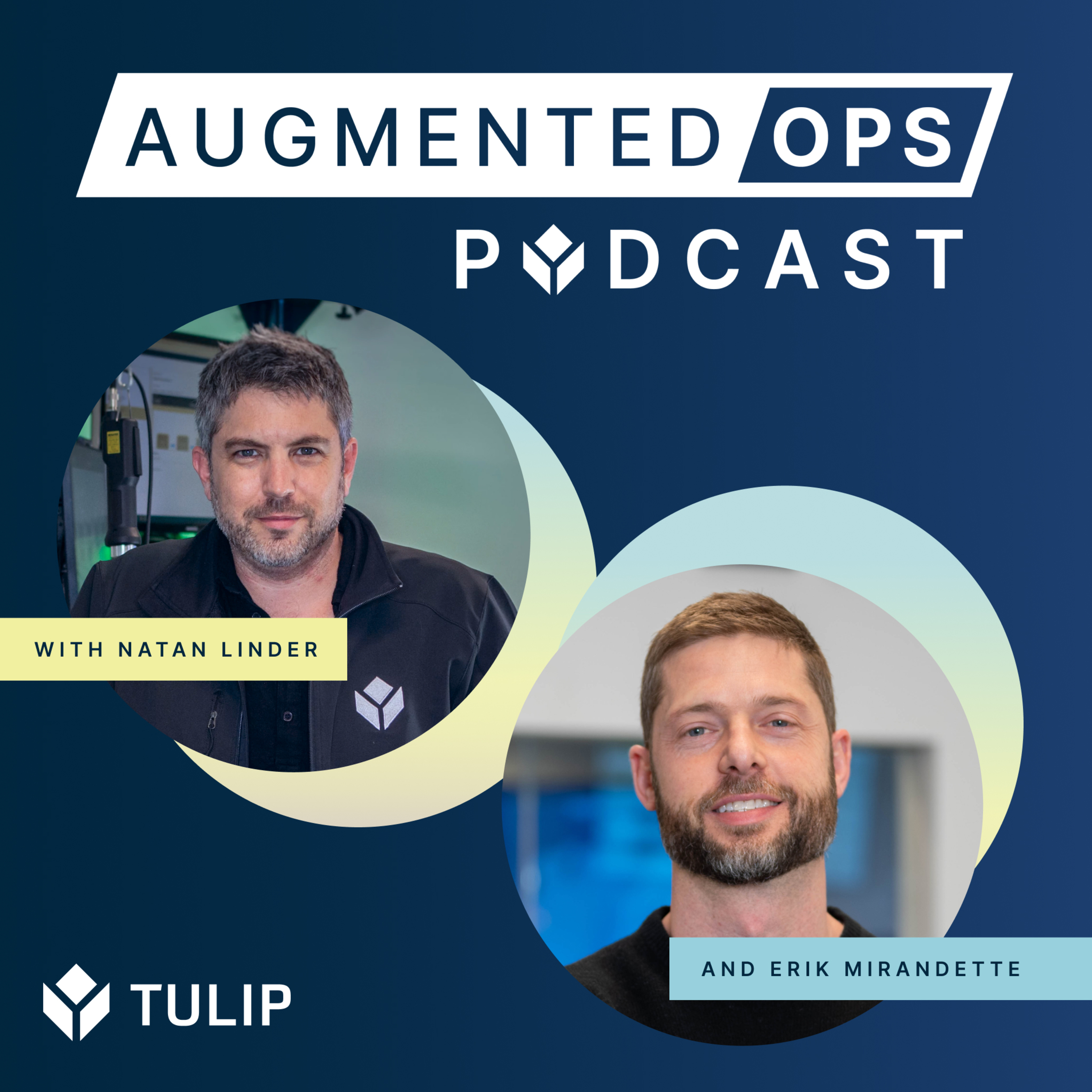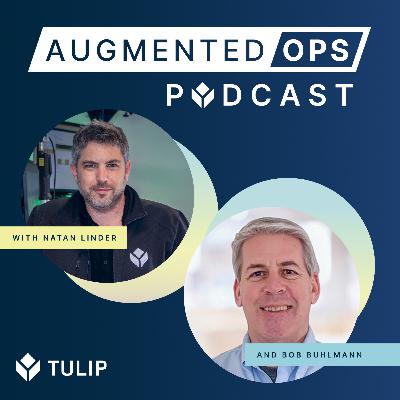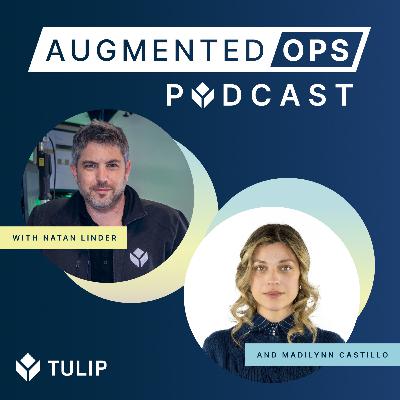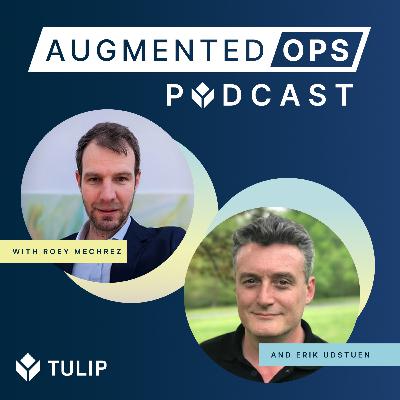Discover Augmented Ops
Augmented Ops

Augmented Ops
Author: Tulip
Subscribed: 28Played: 1,167Subscribe
Share
© 2025 Tulip Interfaces
Description
Augmented Ops is a podcast for industrial leaders, shop floor operators, citizen developers, and anyone else that cares about what the future of frontline operations will look like across industries. We equip our listeners with the knowledge to understand the latest advancements at the intersection of manufacturing and technology, as well as actionable insights that they can implement in their own operations. This show is presented by Tulip, the Frontline Operations Platform.
161 Episodes
Reverse
What does the future of process engineering look like in an era shaped by AI, automation, and rapid operational change? In this episode, Chris Luecke joins Natan Linder to explore how the role is evolving, what still defines great engineering, and why human judgment remains essential on the modern shop floor.
Chris is the host of Manufacturing Happy Hour (https://manufacturinghappyhour.com/) and one of the most connected voices in the industry. Before stepping behind the microphone, he spent years as a process engineer at Anheuser-Busch and later worked across sectors with Rockwell Automation—giving him a rare vantage point on how factories actually run and how engineering teams solve problems.
Natan and Chris discuss the shift from reactive troubleshooting to systems thinking, how culture shapes the pace and quality of improvement, and why the most effective way to introduce AI is to aim it at the tasks teams collectively find painful. They also examine the idea of “Shenzhen Speed,” how faster design and production cycles influence global competitiveness, and what manufacturers elsewhere can learn from regions that move quickly.
This conversation offers an on-the-ground view of how engineering work is changing and what the next generation of process engineers will need to thrive.
Watch the full episode on YouTube (https://youtu.be/lhgRyqJD3X8)
Augmented Ops is a podcast for industrial leaders, citizen developers, shop floor operators, and anyone else that cares about what the future of frontline operations will look like across industries. This show is presented by Tulip, the Frontline Operations Platform. You can find more from us at Tulip.co/podcast or by following the show on LinkedIn.
Special Guest: Chris Luecke.
AI is often described as a revolution, but every technological leap has deep roots in the human story. In this episode of Augmented Ops, MIT Professor and author David Mindell joins Tulip CEO Natan Linder to discuss how history can help us navigate the rise of intelligent systems.
Mindell, a historian, engineer, and entrepreneur, shares insights from his latest book, The New Lunar Society (https://mitpress.mit.edu/9780262049528/the-new-lunar-society/), which traces the origins of the Industrial Revolution and the people who built it. He draws connections between the 18th-century innovators who powered the first era of mechanization and today’s engineers shaping AI. Every tool, he argues, embeds human skill, judgment, and culture; from the earliest steam engines to modern autonomous systems.
Their conversation examines the enduring questions that define manufacturing and technology: How can new tools expand opportunity instead of narrowing it? What does responsible innovation look like in an age of automation? And how can societies balance ambition, governance, and trust while embracing change?
Through stories of invention, work, and rediscovery, Mindell reminds us that progress has always been a human endeavor. Technology evolves, but the drive to create, understand, and improve remains constant.
Watch the full episode on YouTube (https://youtu.be/bn0E-TGS71A)
Augmented Ops is a podcast for industrial leaders, citizen developers, shop floor operators, and anyone else that cares about what the future of frontline operations will look like across industries. This show is presented by Tulip (https://tulip.co/), the Frontline Operations Platform. You can find more from us at Tulip.co/podcast or by following the show on LinkedIn. Special Guest: David Mindell.
Manufacturing is entering a new phase of AI adoption, one where intelligent systems don’t just generate insights but take action in context. In this episode of Augmented Ops, host Mason Glidden, Tulip’s Chief Product Officer, is joined by Olga Stroilova, Group Product Lead, and Pete Hartnett, Group Product Manager, to discuss how agentic AI is redefining what’s possible on the factory floor.
Together, they unpack the evolution from predictive and generative AI to agentic systems capable of autonomous, goal-driven behavior while keeping people firmly in the loop. They examine why many pilots stall before production, how governance and culture shape adoption, and why “human oversight by design” is becoming the new standard for responsible AI in manufacturing.
Drawing from Tulip’s own roadmap and customer experiences, the team highlights how features like AI Composer, Tulip Agents, and context-aware workflows are helping users close the insight-to-action gap, scale AI safely, and unlock new forms of operational leverage.
Rather than imagining a future without people, the episode points to a more realistic vision of AI in manufacturing: one where systems evolve, but human judgment remains the foundation of progress.
Augmented Ops is a podcast for industrial leaders, citizen developers, shop floor operators, and anyone else that cares about what the future of frontline operations will look like across industries. This show is presented by Tulip (https://tulip.co/), the Frontline Operations Platform. You can find more from us at Tulip.co/podcast or by following the show on LinkedIn (https://www.linkedin.com/company/augmentedpod/).
Special Guests: Olga Stroilova and Pete Hartnett.
Kicking off Season 6, Natan and Tulip CMO Madilynn Castillo reflect on Operations Calling 2025 (http://www.OperationsCalling.com)—recorded just after nearly 800 manufacturing leaders, engineers, and frontline pros converged at Tulip HQ for Tulip’s biggest event to date. More than a showcase of technology, this two-day experience blended strategy, execution, and genuine community. Attendees dove into headline keynotes, fireside chats, interactive workshops, and panels, led by senior voices and industry experts driving the new era of manufacturing.
The episode captures how this convergence marked a real inflection point: AI moving from hype to hands-on tools like Tulip Agents, composable systems scaling across teams, and the shift from digital transformation to continuous transformation on the shop floor. Through live demos, open learning, and collaborative problem-solving, participants saw—and built—the next wave of operations-led innovation.
Packed with post-event momentum, Natan and Madi share stories and lessons that reveal how practical AI, human-centered design, and community are reshaping manufacturing’s future.
Augmented Ops is a podcast for industrial leaders, citizen developers, shop floor operators, and anyone who cares about what the future of frontline operations will look like across industries. This show is presented by Tulip, the Frontline Operations Platform. You can find more from us at Tulip.co/podcast or by following the show on LinkedIn.
Check out all the Operations Calling Sessions (https://www.youtube.com/playlist?list=PLeTIPZ3aXjY-yI0Um3FkJARpwrydtTNCw)!
Natan's Keynote (https://youtu.be/ZtqaMAKW7is)
The Next Shift: AI-Driven Transformation of the Connected Factory (https://youtu.be/p625mMYlMSg)
Tulip Roadmap Session (https://youtu.be/ojocCfirJ1s) Special Guest: Madilynn Castillo.
In this bonus episode, our guest is Liz Reynolds, manufacturing and workforce expert at MIT and strategic advisor to Tulip..
Fresh from Detroit's Reindustrialize (https://www.reindustrialize.com) conference, Liz and Natan share key insights on America's urgent push to bring manufacturing back home. They explore the "Spring of momentum" in reindustrialization efforts, from AI moving beyond hype to real implementation on the shop floor, and break down the massive scale challenges facing US manufacturers across critical sectors.
Drawing from major industry conferences including Reindustrialize, the Hill and Valley Forum (https://www.thehillandvalleyforum.com), Industry Studies Association (https://www.industrystudies.org), and MIT's Initiative for New Manufacturing (https://inm.mit.edu), she explains strategic workforce development approaches to address the 400,000 manufacturing worker shortage and the Department of Defense's $1 trillion budget impact on industrial capacity. Reynolds sheds light on how this Spring's discussions and strategic planning around technology adoption and workforce training are beginning to take concrete shape as the real work accelerates into Fall.
Augmented Ops is a podcast for industrial leaders, citizen developers, shop floor operators, and anyone else that cares about what the future of frontline operations will look like across industries. This show is presented by Tulip, the Frontline Operations Platform. You can find more from us at Tulip.co/podcast or by following the show on LinkedIn.
Special Guest: Elisabeth Reynolds.
This week marks the final episode of Season 5 of Augmented Ops! Natan and Erik look back and share their biggest takeaways from conversations with CEOs, frontline engineers, and operations leaders.
They unpack marketing hype vs. the current state of AI on the shop floor, the rise of citizen developers, and why “digital transformation” needs a serious rebrand.
They also dive deep into the demise of traditional MES, explore the shift toward composable, platform-driven architectures, and offer predictions on how adaptability will define manufacturing success in the year of the “composable operations.”
Augmented Ops is a podcast for industrial leaders, citizen developers, shop floor operators, and anyone else that cares about what the future of frontline operations will look like across industries. This show is presented by Tulip (https://tulip.co/), the Frontline Operations Platform. You can find more from us at Tulip.co/podcast (https://tulip.co/podcast) or by following the show on LinkedIn (https://www.linkedin.com/company/augmentedpod/).
This week’s guest is Bob Buhlmann (https://www.linkedin.com/in/bob-buhlmann-4182244/), Head of Quality Digital and Computer Strategy at AstraZeneca.
Bob shares how technology has evolved over the course of his 35+ years in the pharma industry, the hurdles pharma companies often face when adopting emerging technology, and the future of quality management.
He also takes a deep dive into validation, the challenges associated with validating software created by citizen developers, and AstraZeneca’s innovative solution for this pressing problem in the pharma industry.
Augmented Ops is a podcast for industrial leaders, citizen developers, shop floor operators, and anyone else that cares about what the future of frontline operations will look like across industries. This show is presented by Tulip (https://tulip.co/), the Frontline Operations Platform. You can find more from us at Tulip.co/podcast (https://tulip.co/podcast) or by following the show on LinkedIn (https://www.linkedin.com/company/augmentedpod/). Special Guest: Bob Buhlmann.
This week’s guests are Ryan Infantozi (https://www.linkedin.com/in/ryan-infantozzi-202ab723b/) of VEKA, Esmeralda Gonzalez (https://www.linkedin.com/in/esmeralda-gonzalez-m/) of Stanley Black & Decker, and Cuyler Monahan (https://www.linkedin.com/in/cuylermonahan/) of Agility EMS.
The three represent a new generation of frontline engineers—dedicated shop floor problem solvers applying digital technology to tackle the diverse set of challenges each of their operations face on a daily basis.
The three share best practices and lessons learned on the shop floor, how manufacturers can attract the next generation of engineers and operators, and their take on the pros and cons of a citizen development approach to digital transformation.
Augmented Ops is a podcast for industrial leaders, citizen developers, shop floor operators, and anyone else that cares about what the future of frontline operations will look like across industries. This show is presented by Tulip (https://tulip.co/), the Frontline Operations Platform. You can find more from us at Tulip.co/podcast (https://tulip.co/podcast) or by following the show on LinkedIn (https://www.linkedin.com/company/augmentedpod/). Special Guests: Cuyler Monahan, Esmeralda Gonzalez, and Ryan Infantozzi.
This week’s guest is Jim Fox (https://www.linkedin.com/in/james-s-fox/), SVP of Americas Supply Operations at AstraZeneca.
Jim explains how digital manufacturing in pharma has evolved over his nearly 3 decades in the industry, from basic automation and data collection to advanced predictive modeling and integrated digital ecosystems—and why having humans in-the-loop continues to be critical despite these advancements in autonomy.
He also shares his perspective on building trust in emerging technology, the continued importance of lean principles, and the tension between regulation and speed to market.
Augmented Ops is a podcast for industrial leaders, citizen developers, shop floor operators, and anyone else that cares about what the future of frontline operations will look like across industries. This show is presented by Tulip (https://tulip.co/), the Frontline Operations Platform. You can find more from us at Tulip.co/podcast (https://tulip.co/podcast) or by following the show on LinkedIn (https://www.linkedin.com/company/augmentedpod/). Special Guest: Jim Fox.
This week’s guest is Joel Fidalgo (https://www.linkedin.com/in/joel-fidalgo-7b6347121/), CIO of NextPharma.
Joel shares how NextPharma is bridging IT and operations to lead digital transformation across a decentralized CDMO network, and taking a modular, app-based approach to MES and eBR.
He also explores the changing role of the CIO in driving innovation on the shop floor, the importance of cross-functional collaboration, and the challenges of scaling standardized solutions across diverse sites each of which have their own unique requirements.
Augmented Ops is a podcast for industrial leaders, citizen developers, shop floor operators, and anyone else that cares about what the future of frontline operations will look like across industries. This show is presented by Tulip (https://tulip.co/), the Frontline Operations Platform. You can find more from us at Tulip.co/podcast (https://tulip.co/podcast) or by following the show on LinkedIn (https://www.linkedin.com/company/augmentedpod/). Special Guest: Joel Fidalgo.
This week, Natan Linder (https://www.linkedin.com/in/linder/), Co-Founder and CEO of Tulip (https://tulip.co/) sits down with Madilynn Castillo (https://www.linkedin.com/in/madilynncastillo/), Tulip’s CMO for a recap of their experiences at this year’s Hannover Messe—the world’s largest industrial trade fair.
They explore the overwhelming AI hype at the fair, the confusion it creates for manufacturers, and the persistent gap between marketing and real operational impact when it comes to these shiny new tools. Plus, an overview of the latest developments from Tulip that debuted at the show.
Augmented Ops is a podcast for industrial leaders, citizen developers, shop floor operators, and anyone else that cares about what the future of frontline operations will look like across industries. This show is presented by Tulip (https://tulip.co/), the Frontline Operations Platform. You can find more from us at Tulip.co/podcast (https://tulip.co/podcast) or by following the show on LinkedIn (https://www.linkedin.com/company/augmentedpod/). Special Guest: Madilynn Castillo.
This week, we're at Hannover Messe, the world’s largest industrial trade show.
We’re foregoing our usual episode this week, but, we’ll be recording our annual on-site episode at the show later this week covering the state of the industry, analyzing the trends we’re seeing, and cutting through the hype to figure out which of the latest technologies on display here at Hannover will have real impact on the shop floor.
We’ll be back to our regularly scheduled programming next Wednesday. Stay tuned!
Augmented Ops is a podcast for industrial leaders, citizen developers, shop floor operators, and anyone else that cares about what the future of frontline operations will look like across industries. This show is presented by Tulip (https://tulip.co/), the Frontline Operations Platform. You can find more from us at Tulip.co/podcast (https://tulip.co/podcast) or by following the show on LinkedIn (https://www.linkedin.com/company/augmentedpod/).
This week’s guest is Audrey Van de Castle (https://www.linkedin.com/in/audrey-van-de-castle/), Senior Director of Operational Excellence Technology at Stanley Black & Decker.
Audrey breaks down the challenges of scaling digital initiatives across 100+ manufacturing sites, how to balance governance with citizen development, and the need to move past the buzzwords and invest in technology that can make a difference on the shop floor today.
She also shares insights into her unconventional career path from running a makerspace to becoming a digital transformation leader, best practices for working with IT, and her passion for building fighting robots (https://youtu.be/4fbwtajq5XA).
Augmented Ops is a podcast for industrial leaders, citizen developers, shop floor operators, and anyone else that cares about what the future of frontline operations will look like across industries. This show is presented by Tulip (https://tulip.co/), the Frontline Operations Platform. You can find more from us at Tulip.co/podcast (https://tulip.co/podcast) or by following the show on LinkedIn (https://www.linkedin.com/company/augmentedpod/). Special Guest: Audrey Van de Castle.
This week’s guest is Erik Udstuen (https://www.linkedin.com/in/erik-udstuen-00000), Co-founder and CEO of TwinThread.
Erik shares insights from his 30+ years in industrial software, discussing how AI and digital twins are transforming manufacturing by standardizing data, optimizing operations, and driving operational excellence.
He also dives into the challenges of industrial data standards, the importance of empowering engineers with no-code/low-code tools, and why AI must go beyond insights to deliver real-time, actionable recommendations on the shop floor.
Augmented Ops is a podcast for industrial leaders, citizen developers, shop floor operators, and anyone else that cares about what the future of frontline operations will look like across industries. This show is presented by Tulip (https://tulip.co/), the Frontline Operations Platform. You can find more from us at Tulip.co/podcast (https://tulip.co/podcast) or by following the show on LinkedIn (https://www.linkedin.com/company/augmentedpod/). Special Guest: Erik Udstuen.
This week’s guest is Nicolette Naya (https://www.linkedin.com/in/nicolettenaya/), Senior MES Engineer at a leading luxury jewelry manufacturer.
Nicolette shares insights into how she helped digitize centuries-old manufacturing processes, the challenges of introducing technology to the shop floor, and the importance of a structured governance model to successful digital transformation.
She also explores the role of citizen developers, sheds light on her own career path from intern to digital transformation leader, and shares advice for others looking to follow in her footsteps.
Augmented Ops is a podcast for industrial leaders, citizen developers, shop floor operators, and anyone else that cares about what the future of frontline operations will look like across industries. This show is presented by Tulip (https://tulip.co/), the Frontline Operations Platform. You can find more from us at Tulip.co/podcast (https://tulip.co/podcast) or by following the show on LinkedIn (https://www.linkedin.com/company/augmentedpod/). Special Guest: Nicolette Naya.
This week’s guest is ZJ van de Weg (https://www.linkedin.com/in/zegerjan/), CEO of FlowFuse.
ZJ shares his journey from an intern at GitLab to now leading FlowFuse, how open-source technology is transforming industrial operations, and why Node-RED has become the go-to platform for low-code manufacturing connectivity.
He also takes a deep dive into the challenges of scaling open source solutions in enterprise environments, the value of an ‘open-core’ business model, and the future of IT/OT collaboration.
Augmented Ops is a podcast for industrial leaders, citizen developers, shop floor operators, and anyone else that cares about what the future of frontline operations will look like across industries. This show is presented by Tulip (https://tulip.co/), the Frontline Operations Platform. You can find more from us at Tulip.co/podcast (https://tulip.co/podcast) or by following the show on LinkedIn (https://www.linkedin.com/company/augmentedpod/). Special Guest: ZJ van de Weg.
This week’s guest is Vijay Chinnasami (https://www.linkedin.com/in/vijayan-chinnasami-6595a931/), former COO of Ultra Clean Technology.
Vijay shares an inside look into how electronics supply chains and manufacturing practices have evolved over his 35+ year career, the rise of EMS and ODM business models, and how the semiconductor industry is shifting in response to global pressures.
The discussion also explores best practices for building a culture of continuous improvement, balancing humans with automation, and adapting management approaches to local cultures.
Augmented Ops is a podcast for industrial leaders, citizen developers, shop floor operators, and anyone else that cares about what the future of frontline operations will look like across industries. This show is presented by Tulip (https://tulip.co/), the Frontline Operations Platform. You can find more from us at Tulip.co/podcast (https://tulip.co/podcast) or by following the show on LinkedIn (https://www.linkedin.com/company/augmentedpod/). Special Guest: Vijay Chinnasami.
This week’s guest is John Harrington (https://www.linkedin.com/in/john-harrington-142906a/), co-founder and Chief Product Officer of HighByte.
John shares how his experiences working on Kepware at PTC led him to co-found HighByte, why Industry 4.0 requires a fundamentally different approach to interoperability, and the importance of contextualizing data in manufacturing.
He also breaks down the real value that a Unified Namespace (UNS) approach can bring, whether frameworks like ISA-95 are still relevant, and the age-old OPC vs MQTT debate.
Augmented Ops is a podcast for industrial leaders, citizen developers, shop floor operators, and anyone else that cares about what the future of frontline operations will look like across industries. This show is presented by Tulip (https://tulip.co/), the Frontline Operations Platform. You can find more from us at Tulip.co/podcast (https://tulip.co/podcast) or by following the show on LinkedIn (https://www.linkedin.com/company/augmentedpod/). Special Guest: John Harrington.
This week’s guest is Kence Anderson (https://www.linkedin.com/in/kence), CEO of Composabl.
Kence and Natan explore the role of AI agents in industrial processes, how manufacturers are using them to solve complex problems like scheduling or machine control, and the challenges of building startups in the manufacturing space. Kence also lays out how his concept of machine teaching differs from traditional machine learning techniques, and why he believes in taking a composable approach to building solutions for problems on the shop floor.
Augmented Ops is a podcast for industrial leaders, citizen developers, shop floor operators, and anyone else that cares about what the future of frontline operations will look like across industries. This show is presented by Tulip (https://tulip.co/), the Frontline Operations Platform. You can find more from us at Tulip.co/podcast (https://tulip.co/podcast) or by following the show on LinkedIn (https://www.linkedin.com/company/augmentedpod/). Special Guest: Kence Anderson.
This week’s guest is Fabio Violante (https://www.linkedin.com/in/fabioviolante), CEO of Arduino.
Fabio and Natan explore the importance of open source technology in manufacturing and how the democratization of embedded systems development is reshaping the industry. Fabio also shares the history of Arduino, and how he led the charge to evolve their approach from focusing purely on makers and hobbyists, to supporting enterprise grade applications with a new line of hardware.
Augmented Ops is a podcast for industrial leaders, citizen developers, shop floor operators, and anyone else that cares about what the future of frontline operations will look like across industries. This show is presented by Tulip (https://tulip.co/), the Frontline Operations Platform. You can find more from us at Tulip.co/podcast (https://tulip.co/podcast) or by following the show on LinkedIn (https://www.linkedin.com/company/augmentedpod/). Special Guest: Fabio Violante.


